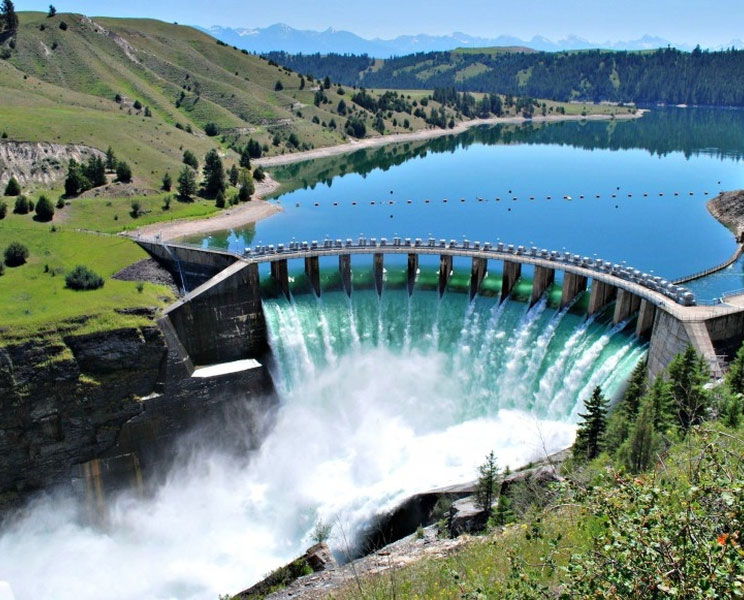Origin of renewable energy sources [ctd.]

1.6 Power of water: Hydropower
Hydropower is the oldest source of renewable energy that the mankind has been using to generate electricity in large-scale. It has a long history as a source of energy. It was used by ancient people for irrigation and to power some mechanical systems such as sawmills and flour mills. In the late 19thcentury, people realized that the kinetic energy of falling water could be coupled with a turbine and a generator to generate electricity. Thereby, world’s first hydropower plant was opened in 1882 on the Fox River in Appleton in the United States [1].
Unlike other renewable energy sources we discussed in previous articles, hydropower or power of water is widely being used around the globe and is the second largest contributor to the today’s renewable energy industry (Largest contributor is traditional biomass). It is a proven way of replacing the role of fossil fuels in electricity generation. One clear example would be Bhutan which is a carbon negative country thanks to its vast amount of hydropower available. Norway is another green country generating 98.9% of its electricity using hydropower [2]. In addition, many other countries are generating substantial amount of hydroelectricity.
Origin of hydropower
It is needless to say that hydropower entirely relies on continuous supply of water from an elevated position. Water falling from an elevated position turns a turbine installed at a lower position. The electrical generator attached to the turbine thereby generates electricity to the rhythm of the water flows through the turbine.
Water enters the system at a higher position, deliver its kinetic energy to a turbine and exits the system at a lower position.
To keep the plant running (generating electricity), water should be continuously running through the turbine. In other words, water should be directed back to the higher position from the lower level. This is naturally done by the Sun in a process called “water cycle” or “Hydrologic cycle”.
How does it work?
The Sun’s heat evaporates water from the oceans, rivers, lakes, trees, soil and all the water bodies. Evaporated water molecules or Water vapor moves up and form clouds in the sky. Water molecules in clouds then cool and condense into raindrops or snow once the temperature reaches the dew point and fall back to the ground as precipitation. This process is a never-ending, cyclic natural process and therefore, is referred to as “water cycle”.
During the complete process, water is brought from lower levels to higher levels and thereby water stores Sun’s energy in the form of potential energy. Therefore, hydropower is an indirect source solar energy and is a renewable energy source.
Water cycle is the sole driving force of hydropower and ensures the continuous supply of water by which water is repeatedly cycled through the turbines.
Hydropower: General background
A typical hydropower plant consists of a dam (not necessary for some cases), a turbine, an electrical generator and transmission lines.
First, the kinetic energy of falling water is converted into mechanical energy of turbines. An electrical generator attached to the turbine converts the mechanical energy of the turbine into electricity which is then distributed through power transmission lines.
Hydropower plants are often classified according to their operational principle as below.
Storage hydropower
Run of river
Run of river (ROR) represents a type of hydropower which typically requires no or little water storage. ROR hydropower plants are extremely intermittent as they are not regulated by large storage or dams. However, they could be built with no or minimal alteration to the surrounding. In particular, environmental impacts of ROR hydropower plants are insignificant compared to conventional hydropower plants which require large-scale water storage, dams, onsite and nearby alterations.
Pumped storage hydropower
Pumped-storage hydropower as its name suggests is a type of energy storage. These hydro power plants pump water to a higher elevation from a lower elevation during off-peak hours and thereby store energy surplus in the form of potential energy. During the peak hours, pumped water is released through a turbine to generate electricity.
The capacity of hydropower plants may range from few kilo watts to several Giga Watts. Depending on the size of power capacity, hydropower plants are categorized into several groups as mentioned below [3, 4].
Large hydro
Plants having capacity of 100 MW or more.
The worldwide technically accessible hydropower capacity has been estimated to be 2200 GW. However, only 25% of this figure is currently being used for electricity generation.
Medium Hydro
Plants having the capacity in the range of 25 MW-100 MW
Small Hydro
Plants having the capacity in the range of 1 MW-25MW
Mini Hydro
Plants having the capacity in the range of 100 kW-MW
Micro Hydro
Plants having the capacity in the range of 5 kW-100 kW
Pico Hydro
Plants having the capacity of 5 kW or less
Some important facts
- Hydropower provides 2.2% of the world’s primary energy demand [5]
- Hydropower represents the third largest single contributor to the global electricity generation and it accounted for 17.9% in 2007 [5]
- World’s cumulative hydropower capacity reached 970 GW in 2011 [6]
- Paraguay, Venezuela, Brazil, China, Canada, United States of America, and India are some of the countries having large-scale hydropower plants.
- Norway, Brazil, Bhutan and Venezuela heavily rely on hydropower to generate electricity
- World’s largest hydroelectric project, Three Gorges Dam in China has been designed to generate 22500 MW of power [7] which is 5 times higher than the total installed capacity in Sri Lanka (The cumulative power generation capacity of grid-connected power plants in Sri Lanka was 3,887 MW in 2016 according to the public utilities commission of Sri Lanka) [7].
- World’s second largest hydroelectric project, Itaipu (Paraguay and Brazil) generates 14,000 MW of power [8]
Unlike other energy sources we discussed in previous articles, hydropower can play a vital role in the renewable energy industry, especially in supply-demand management. In next article, we will further discuss hydropower in detail.
